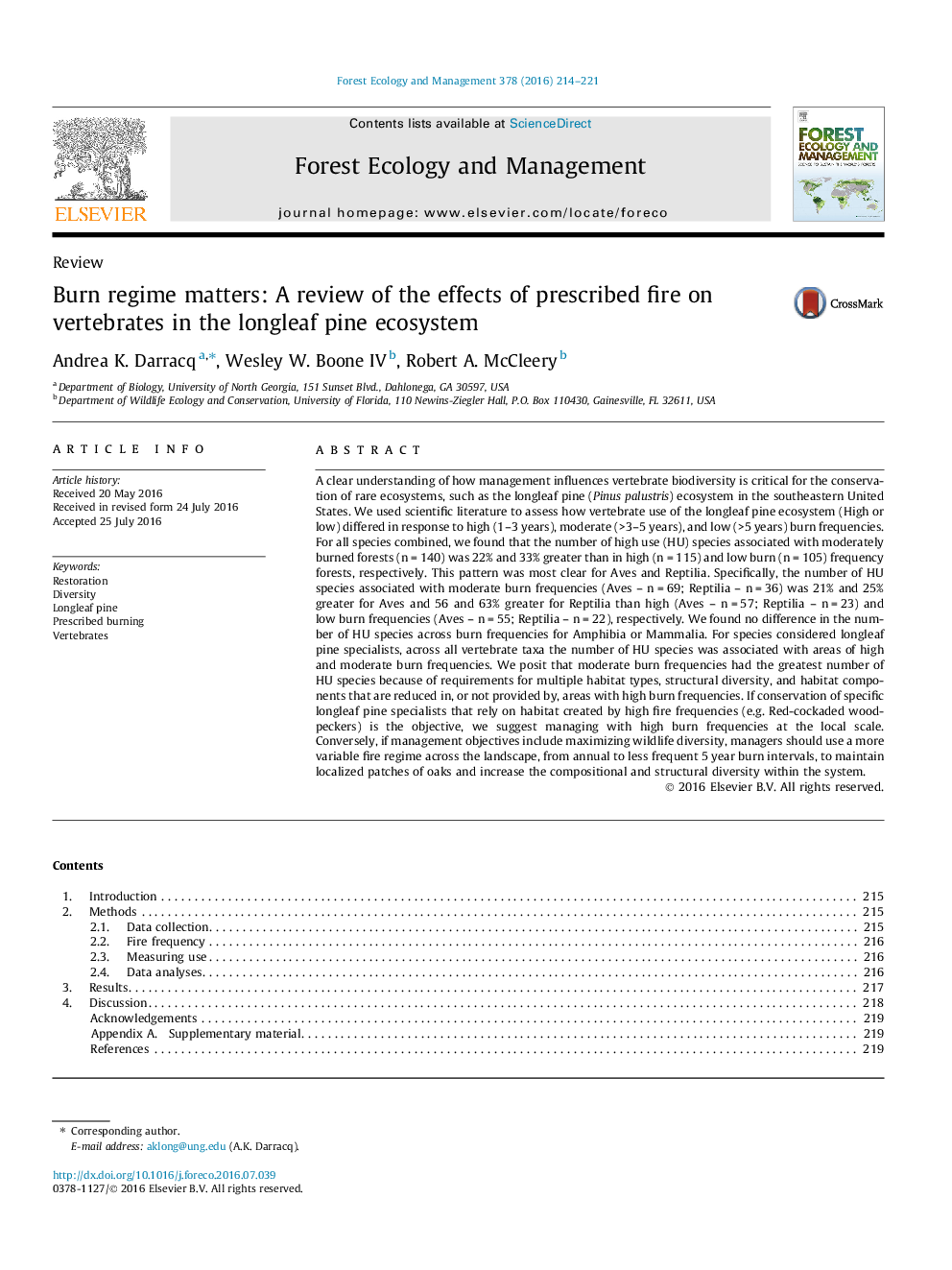| کد مقاله | کد نشریه | سال انتشار | مقاله انگلیسی | نسخه تمام متن |
|---|---|---|---|---|
| 6542013 | 159144 | 2016 | 8 صفحه PDF | دانلود رایگان |
عنوان انگلیسی مقاله ISI
Burn regime matters: A review of the effects of prescribed fire on vertebrates in the longleaf pine ecosystem
ترجمه فارسی عنوان
مسائل مربوط به رژیم ریزش: بررسی اثر آتش سوزی مجاز در مهره داران در اکوسیستم کاج طولانی
دانلود مقاله + سفارش ترجمه
دانلود مقاله ISI انگلیسی
رایگان برای ایرانیان
کلمات کلیدی
موضوعات مرتبط
علوم زیستی و بیوفناوری
علوم کشاورزی و بیولوژیک
بوم شناسی، تکامل، رفتار و سامانه شناسی
چکیده انگلیسی
A clear understanding of how management influences vertebrate biodiversity is critical for the conservation of rare ecosystems, such as the longleaf pine (Pinus palustris) ecosystem in the southeastern United States. We used scientific literature to assess how vertebrate use of the longleaf pine ecosystem (High or low) differed in response to high (1-3 years), moderate (>3-5 years), and low (>5 years) burn frequencies. For all species combined, we found that the number of high use (HU) species associated with moderately burned forests (n = 140) was 22% and 33% greater than in high (n = 115) and low burn (n = 105) frequency forests, respectively. This pattern was most clear for Aves and Reptilia. Specifically, the number of HU species associated with moderate burn frequencies (Aves - n = 69; Reptilia - n = 36) was 21% and 25% greater for Aves and 56 and 63% greater for Reptilia than high (Aves - n = 57; Reptilia - n = 23) and low burn frequencies (Aves - n = 55; Reptilia - n = 22), respectively. We found no difference in the number of HU species across burn frequencies for Amphibia or Mammalia. For species considered longleaf pine specialists, across all vertebrate taxa the number of HU species was associated with areas of high and moderate burn frequencies. We posit that moderate burn frequencies had the greatest number of HU species because of requirements for multiple habitat types, structural diversity, and habitat components that are reduced in, or not provided by, areas with high burn frequencies. If conservation of specific longleaf pine specialists that rely on habitat created by high fire frequencies (e.g. Red-cockaded woodpeckers) is the objective, we suggest managing with high burn frequencies at the local scale. Conversely, if management objectives include maximizing wildlife diversity, managers should use a more variable fire regime across the landscape, from annual to less frequent 5 year burn intervals, to maintain localized patches of oaks and increase the compositional and structural diversity within the system.
ناشر
Database: Elsevier - ScienceDirect (ساینس دایرکت)
Journal: Forest Ecology and Management - Volume 378, 15 October 2016, Pages 214-221
Journal: Forest Ecology and Management - Volume 378, 15 October 2016, Pages 214-221
نویسندگان
Andrea K. Darracq, Wesley W. IV, Robert A. McCleery,
